Aminophylline - Study guides, Class notes & Summaries
Looking for the best study guides, study notes and summaries about Aminophylline? On this page you'll find 839 study documents about Aminophylline.
Page 3 out of 839 results
Sort by
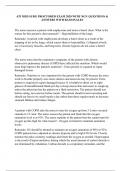
-
ATI MED SURG PROCTORED EXAM 2020 WITH NGN QUESTIONS & ANSWERS WITH RATIONALES
- Exam (elaborations) • 18 pages • 2024
-
- $13.00
- + learn more
The nurse assesses a patient with emphysema and notes a barrel chest. What is the reason for this patient's chest anomaly? - Hyperinflation of the lungs Rationale: A patient with emphysema develops a barrel chest as a result of the trapping of air in the lungs, which causes them to hyperinflate. Collapsed alveoli, use of accessory muscles, and long-term, chronic hypoxia do not cause a barrel chest. The nurse notes that the respiratory symptoms of the patient with chronic obstructive pulm...
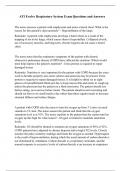
-
ATI Evolve Respiratory System Exam Questions and Answers
- Exam (elaborations) • 18 pages • 2024
-
- $10.00
- + learn more
The nurse assesses a patient with emphysema and notes a barrel chest. What is the reason for this patient's chest anomaly? - Hyperinflation of the lungs Rationale: A patient with emphysema develops a barrel chest as a result of the trapping of air in the lungs, which causes them to hyperinflate. Collapsed alveoli, use of accessory muscles, and long-term, chronic hypoxia do not cause a barrel chest. The nurse notes that the respiratory symptoms of the patient with chronic obstructive pulm...
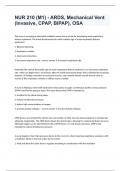
-
NUR 210 (M1) - ARDS, Mechanical Vent (Invasive, CPAP, BIPAP), OSA with complete solutions 2024
- Exam (elaborations) • 25 pages • 2024
- Available in package deal
-
- $17.99
- + learn more
NUR 210 (M1) - ARDS, Mechanical Vent (Invasive, CPAP, BIPAP), OSAThe nurse is assessing a client with multiple trauma who is at risk for developing acute respiratory distress syndrome. The nurse should assess for which earliest sign of acute respiratory distress syndrome? 1. Bilateral wheezing 2. Inspiratory crackles 3. Intercostal retractions 4. Increased respiratory rate - correct answer 4. Increased respiratory rate Rationale:The earliest detectable sign of acute respiratory distress s...
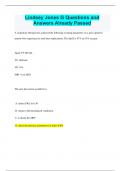
-
Lindsey Jones G Questions and Answers Already Passed
- Exam (elaborations) • 72 pages • 2024
-
Available in package deal
-
- $12.49
- + learn more
Lindsey Jones G Questions and Answers Already Passed A respiratory therapist has achieved the following weaning parameters on a post-operative patient who experienced a total knee replacement. The SpO2 is 97% on 35% oxygen. Spont VT 480 mL VC 1600 mL VE 7.0 L MIP -4 cm H2O The next best action would be to A. reduce FIO2 to 0.30 B. return to full mechanical ventilation C. evaluate the MEF D. check the pressure manometer for leaks D In preparation for a smoking cessation...
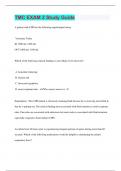
-
TMC EXAM 2 Study Guide
- Exam (elaborations) • 90 pages • 2024
-
Available in package deal
-
- $11.99
- + learn more
TMC EXAM 2 Study Guide A patient with CHF has the following input/output history Yesterday Today IN 1900 mL 2100 mL OUT 1000 mL 1100 mL Which of the following clinical findings is most likely to be observed? A. bronchial wheezing B. friction rub C. decreased egophony D. moist crepitant rales - The correct answer is : D Explanation : This CHF patient is obviously retaining fluid because he is receiving more fluid in that he is putting out. The clinical finding most associated...
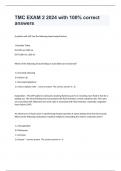
-
TMC EXAM 2 2024 with 100% correct answers
- Exam (elaborations) • 64 pages • 2024
-
Available in package deal
-
- $15.49
- + learn more
A patient with CHF has the following input/output history Yesterday Today IN 1900 mL 2100 mL OUT 1000 mL 1100 mL Which of the following clinical findings is most likely to be observed? A. bronchial wheezing B. friction rub C. decreased egophony D. moist crepitant rales - correct answer The correct answer is : D Explanation : This CHF patient is obviously retaining fluid because he is receiving more fluid in that he is putting out. The clinical finding most associated wit...
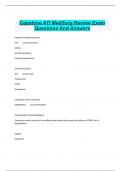
-
Capstone ATI MedSurg Review Exam Questions And Answers
- Exam (elaborations) • 14 pages • 2024
-
- $10.99
- + learn more
Angina Precipitating Factors 4 Es - answer-Exertion Eating Emotional distress Extreme temperature Arterial Occlusion 4Ps - answer-Pain Pulselessnes Parlor Parenthesis Congestive Heart Treatment MADD DOG - answer-Morphine Aminophylline (bronchodilators) -long-term control control of reversible airway obstruction caused by asthma or COPD; salt of theophylline Digoxin Dopamine
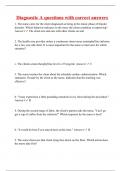
-
Diagnostic A questions with correct answers
- Exam (elaborations) • 44 pages • 2024
-
- $12.49
- + learn more
1. The nurse cares for the client diagnosed as being in the manic phase of bipolar disorder. Which behavior indicates to the nurse the client condition is improving? Answer The client sits and eats with other clients on unit 2. The health care provider orders a continuous intravenous aminophylline infusion for a two year old client. It is most important for the nurse to intervene for which situation? c. The clients serum theophylline level is 25 mcg/mL Answer C 3. The nurse teaches th...
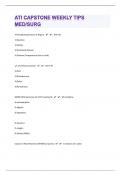
-
ATI Capstone Weekly Tips Med/Surg 96 Questions with 100% Correct Answers | Updated & Verified
- Exam (elaborations) • 19 pages • 2024
-
- $7.99
- + learn more
4 Precipitating Factors of Angina - ️️The 4 Es 1) Exertion 2) Eating 3) Emotional distress 4) Extreme Temperature (hot or cold) s/s of arterial occlusion - ️️The 4 Ps 1) Pain 2) Pulselessness 3) Pallor 4) Paresthesia MADD DOG (acronym for CHF treatment) - ️️M-morphine A-aminophylline D-digoxin D-dopamine D-diuretics O-oxygen G-Gasses (ABGs)
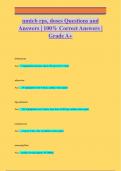
-
nmtcb rps, doses Questions and Answers | 100% Correct Answers | Grade A+
- Exam (elaborations) • 12 pages • 2024
- Available in package deal
-
- $13.39
- + learn more
dobutamine Ans: 5 ug/kg/min increases (up to 40 ug) every 3 mins adenosine Ans: .14 mg/kg/min over 4 mins, cardiac stress agent dipyridamole Ans: .142 mg/kg/min over 4 mins, max dose of 60 mg, cardiac stress agent regadenoson Ans: .4 mg in 5 mL, A2a vasodilator stress agent aminophylline Ans: cardiac reversal agent, 50-100mg esmolol Ans: cardiac reversal agent, 500ug/kg/min sincalide (kinevac) Ans: CCK, GB contraction, .02ug/kg via infusion pump morphine Ans: sphincter of oddi con...

Do you wonder why so many students wear nice clothes, have money to spare and enjoy tons of free time? Well, they sell on Stuvia! Imagine your study notes being downloaded a dozen times for $15 each. Every. Single. Day. Discover all about earning on Stuvia


